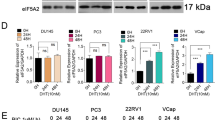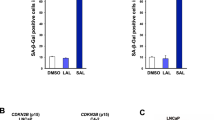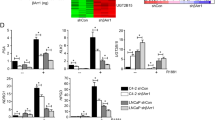Abstract
We have previously demonstrated that human H2-relaxin can mediate androgen-independent growth of LNCaP through a mechanism that involves the activation of the androgen receptor (AR) signaling pathway. The goal of the current study is to elucidate the mechanism(s) by which H2-relaxin causes activation of the AR pathway. Our data indicate that there is cross-talk between AR and components of the Wnt signaling pathway. Addition of H2-relaxin to LNCaP cells resulted in increased phosphorylation of protein kinase B (Akt) and inhibitory phosphorylation of glycogen synthase kinase-3β (GSK-3β) with subsequent cytoplasmic accumulation of β-catenin. Immunoprecipitation and immunocytochemical studies demonstrated that the stabilized β-catenin formed a complex with AR, which was then translocated into the nucleus. Chromatin immunoprecipitation analysis determined that the AR/β-catenin complex binds to the proximal region of the prostate-specific antigen promoter. Inhibition of the phosphatidylinositol 3-kinase (PI3K)/Akt pathway, using LY294002, prevented both H2-relaxin-mediated phosphorylation of Akt and GSK-3β and translocation of β-catenin/AR into the nucleus. Knockdown of β-catenin levels using a β-catenin-specific small interfering RNA inhibited H2-relaxin-induced AR activity. The combined data demonstrate that PI3K/Akt and components of the Wnt pathway can facilitate H2-relaxin-mediated activation of the AR pathway.
This is a preview of subscription content, access via your institution
Access options
Subscribe to this journal
Receive 50 print issues and online access
$259.00 per year
only $5.18 per issue
Buy this article
- Purchase on Springer Link
- Instant access to full article PDF
Prices may be subject to local taxes which are calculated during checkout







Similar content being viewed by others
References
Bartsch O, Bartlick B, Ivell R . (2001). Relaxin signalling links tyrosine phosphorylation to phosphodiesterase and adenylyl cyclase activity. Mol Hum Reprod 7: 799–809.
Castellone MD, Teramoto H, Williams BO, Druey KM, Gutkind JS . (2005). Prostaglandin E2 promotes colon cancer cell growth through a Gs-axin-beta-catenin signaling axis. Science 310: 1504–1510.
Cronauer MV, Schulz WA, Ackermann R, Burchardt M . (2005). Effects of WNT/beta-catenin pathway activation on signaling through T-cell factor and androgen receptor in prostate cancer cell lines. Int J Oncol 26: 1033–1040.
Cross DA, Alessi DR, Cohen P, Andjelkovich M, Hemmings BA . (1995). Inhibition of glycogen synthase kinase-3 by insulin mediated by protein kinase B. Nature 378: 785–789.
Desai SJ, Ma AH, Tepper CG, Chen HW, Kung HJ . (2006). Inappropriate activation of the androgen receptor by nonsteroids: involvement of the Src kinase pathway and its therapeutic implications. Cancer Res 66: 10449–10459.
Dessauer CW, Nguyen BT . (2005). Relaxin stimulates multiple signaling pathways: activation of cAMP, PI3K, and PKCzeta in THP-1 cells. Ann N Y Acad Sci 1041: 272–279.
di Sant'Agnese PA, Cockett AT . (1996). Neuroendocrine differentiation in prostatic malignancy. Cancer 78: 357–361.
Dinjens WN, van der Weiden MM, Schroeder FH, Bosman FT, Trapman J . (1994). Frequency and characterization of p53 mutations in primary and metastatic human prostate cancer. Int J Cancer 56: 630–633.
Eastman Q, Grosschedl R . (1999). Regulation of LEF-1/TCF transcription factors by Wnt and other signals. Curr Opin Cell Biol 11: 233–240.
Figueiredo KA, Palmer JB, Mui AL, Nelson CC, Cox ME . (2005). Demonstration of upregulated H2 relaxin mRNA expression during neuroendocrine differentiation of LNCaP prostate cancer cells and production of biologically active mammalian recombinant 6 histidine-tagged H2 relaxin. Ann N Y Acad Sci 1041: 320–327.
Halls ML, Bathgate RA, Roche PJ, Summers RJ . (2005a). Signaling pathways of the LGR7 and LGR8 receptors determined by reporter genes. Ann N Y Acad Sci 1041: 292–295.
Halls ML, Bathgate RA, Summers RJ . (2005b). Signal switching after stimulation of LGR7 receptors by human relaxin 2. Ann N Y Acad Sci 1041: 288–291.
Hsu SY, Nakabayashi K, Nishi S, Kumagai J, Kudo M, Sherwood OD et al. (2002). Activation of orphan receptors by the hormone relaxin. Science 295: 671–674.
Huss WJ, Gregory CW, Smith GJ . (2004). Neuroendocrine cell differentiation in the CWR22 human prostate cancer xenograft: association with tumor cell proliferation prior to recurrence. Prostate 60: 91–97.
Ivell R . (2002). Endocrinology. This hormone has been relaxin' too long!. Science 295: 637–638.
Lee LF, Louie MC, Desai SJ, Yang J, Chen HW, Evans CP et al. (2004). Interleukin-8 confers androgen-independent growth and migration of LNCaP: differential effects of tyrosine kinases Src and FAK. Oncogene 23: 2197–2205.
Louie MC, Yang HQ, Ma AH, Xu W, Zou JX, Kung HJ et al. (2003). Androgen-induced recruitment of RNA polymerase II to a nuclear receptor-p160 coactivator complex. Proc Natl Acad Sci USA 100: 2226–2230.
Miller JR, Moon RT . (1996). Signal transduction through beta-catenin and specification of cell fate during embryogenesis. Genes Dev 10: 2527–2539.
Morin PJ, Sparks AB, Korinek V, Barker N, Clevers H, Vogelstein B et al. (1997). Activation of beta-catenin-Tcf signaling in colon cancer by mutations in beta-catenin or APC. Science 275: 1787–1790.
Murga C, Laguinge L, Wetzker R, Cuadrado A, Gutkind JS . (1998). Activation of Akt/protein kinase B by G protein-coupled receptors. A role for alpha and beta gamma subunits of heterotrimeric G proteins acting through phosphatidylinositol-3-OH kinasegamma. J Biol Chem 273: 19080–19085.
Nesslinger NJ, Shi XB, deVere White RW . (2003). Androgen-independent growth of LNCaP prostate cancer cells is mediated by gain-of-function mutant p53. Cancer Res 63: 2228–2233.
Nguyen BT, Yang L, Sanborn BM, Dessauer CW . (2003). Phosphoinositide 3-kinase activity is required for biphasic stimulation of cyclic adenosine 3′,5′-monophosphate by relaxin. Mol Endocrinol 17: 1075–1084.
Nusse R . (1997). A versatile transcriptional effector of Wingless signaling. Cell 89: 321–323.
Nusse R . (2005). Wnt signaling in disease and in development. Cell Res 15: 28–32.
Palejwala S, Stein D, Wojtczuk A, Weiss G, Goldsmith LT . (1998). Demonstration of a relaxin receptor and relaxin-stimulated tyrosine phosphorylation in human lower uterine segment fibroblasts. Endocrinology 139: 1208–1212.
Pang S, Dannull J, Kaboo R, Xie Y, Tso CL, Michel K et al. (1997). Identification of a positive regulatory element responsible for tissue-specific expression of prostate-specific antigen. Cancer Res 57: 495–499.
Polakis P . (2000). Wnt signaling and cancer. Genes Dev 14: 1837–1851.
Reya T, Clevers H . (2005). Wnt signalling in stem cells and cancer. Nature 434: 843–850.
Sherwood OD . (2004). Relaxin's physiological roles and other diverse actions. Endocr Rev 25: 205–234.
Shi XB, Gandour-Edwards R, Beckett LA, Deitch AD, de Vere White RW . (2004). A modified yeast assay used on archival samples of localized prostate cancer tissue improves the detection of p53 abnormalities and increases their predictive value. BJU Int 94: 996–1002.
Silvertown JD, Geddes BJ, Summerlee AJ . (2003). Adenovirus-mediated expression of human prorelaxin promotes the invasive potential of canine mammary cancer cells. Endocrinology 144: 3683–3691.
Song SY, Kim S, Kim DS, Son HJ, Rhee JC, Kim YI . (2004). Abnormal expression of E-cadherin in early gastric carcinoma: its relationship with macroscopic growth patterns and catenin alpha and beta. J Clin Gastroenterol 38: 252–259.
Stoyanov B, Volinia S, Hanck T, Rubio I, Loubtchenkov M, Malek D et al. (1995). Cloning and characterization of a G protein-activated human phosphoinositide-3 kinase. Science 269: 690–693.
Truica CI, Byers S, Gelmann EP . (2000). Beta-catenin affects androgen receptor transcriptional activity and ligand specificity. Cancer Res 60: 4709–4713.
Verras M, Brown J, Li X, Nusse R, Sun Z . (2004). Wnt3a growth factor induces androgen receptor-mediated transcription and enhances cell growth in human prostate cancer cells. Cancer Res 64: 8860–8866.
Vinall RL, Tepper CG, Shi XB, Xue LA, Gandour-Edwards R, de Vere White RW . (2006). The R273H p53 mutation can facilitate the androgen-independent growth of LNCaP by a mechanism that involves H2 relaxin and its cognate receptor LGR7. Oncogene 25: 2082–2093.
Vlietstra RJ, van Alewijk DC, Hermans KG, van Steenbrugge GJ, Trapman J . (1998). Frequent inactivation of PTEN in prostate cancer cell lines and xenografts. Cancer Res 58: 2720–2723.
Yang F, Li X, Sharma M, Sasaki CY, Longo DL, Lim B et al. (2002). Linking beta-catenin to androgen-signaling pathway. J Biol Chem 277: 11336–11344.
Yang X, Chen MW, Terry S, Vacherot F, Bemis DL, Capodice J et al. (2006). Complex regulation of human androgen receptor expression by Wnt signaling in prostate cancer cells. Oncogene 25: 3436–3444.
Yost C, Torres M, Miller JR, Huang E, Kimelman D, Moon RT . (1996). The axis-inducing activity, stability, and subcellular distribution of beta-catenin is regulated in Xenopus embryos by glycogen synthase kinase 3. Genes Dev 10: 1443–1454.
Yuan TC, Veeramani S, Lin FF, Kondrikou D, Zelivianski S, Igawa T et al. (2006). Androgen deprivation induces human prostate epithelial neuroendocrine differentiation of androgen-sensitive LNCaP cells. Endocr Relat Cancer 13: 151–167.
Zhang Q, Liu SH, Erikson M, Lewis M, Unemori E . (2002). Relaxin activates the MAP kinase pathway in human endometrial stromal cells. J Cell Biochem 85: 536–544.
Acknowledgements
We thank Dr AF Parlow of the National Hormone and Peptide Program, NIDDK for providing us with the recombinant human H2-relaxin and Dr ZJ Sun (Stanford University) for pcDNA3.1-β-catenin plasmid construction. The present work is supported by NIH and DOD grants to HJK and RWD. We acknowledge the support of CCSG (Cancer Center Support Grant) to UC Davis Cancer Center.
Author information
Authors and Affiliations
Corresponding authors
Additional information
Supplementary Information accompanies the paper on the Oncogene website (http://www.nature.com/onc).
Supplementary information
Rights and permissions
About this article
Cite this article
Liu, S., Vinall, R., Tepper, C. et al. Inappropriate activation of androgen receptor by relaxin via β-catenin pathway. Oncogene 27, 499–505 (2008). https://doi.org/10.1038/sj.onc.1210671
Received:
Revised:
Accepted:
Published:
Issue Date:
DOI: https://doi.org/10.1038/sj.onc.1210671



